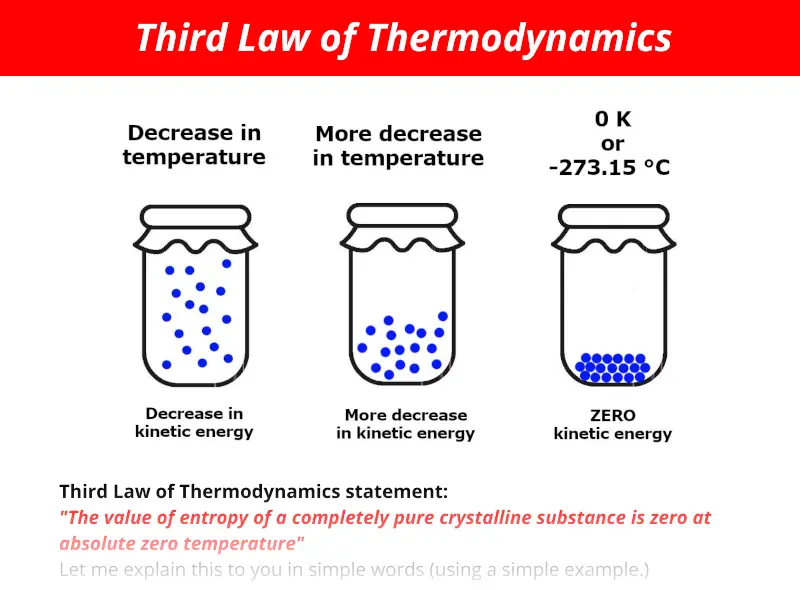
Let me tell you a story before starting the third law of thermodynamics.

When German chemist Walther Hermann Nernst studied about the second law of thermodynamics, his mind was completely disturbed.
He studied that the entropy of the universe keeps on increasing for all the process occurring on it’s own.
He thought that, what should be done so that the entropy of the universe will not increase and it will remain constant?
Then he studied everything about entropy. After a lot of studying and research work, he discovered the third law of thermodynamics.
He stated Third law of thermodynamics as;
“The value of entropy of a completely pure crystalline substance is zero at absolute zero temperature”
I know it seems little bit difficult for you to understand what this Third law wants to say?
I’ll explain to you everything about the 3rd law of thermodynamics. (You will definitely love to read this)
If you want to skip to any of your interested topics, feel free to read it from the below table.
You can also refer basics of thermodynamics as well as previous laws of thermodynamics which are explained with amazing examples which makes you remember all these things easily.
- Basics of thermodynamics
- Zeroth law of thermodynamics
- First law of thermodynamics
- Second law of thermodynamics
Contents
What is Randomness and Entropy in Third law? (You need to know this)
Before starting the Third law of thermodynamics, I would like to explain two terms;
- Randomness
- Entropy
1) Randomness:
The movement of molecules is known as randomness.

See this, how quiet the students are sitting on their bench and they are not moving at all. This is exactly the situation when there is a strict teacher in your class. Isn’t it?

I guess this is the exact situation which is seen during the recess time.
Students are moving here and there in a classroom.
Now you will come to know what randomness is. See in the first image, the students are not moving, that means they are just sitting on their position. Thus, their randomness is zero.
But in the second figure, the students are moving here and there during a recess time. This means that their randomness is more.
This is a simple concept of randomness.
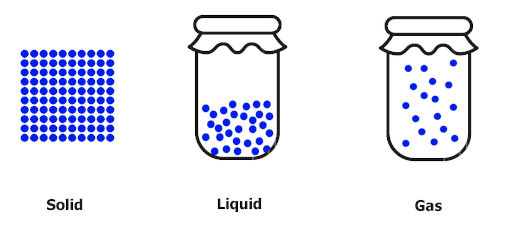
Same thing happens in solids, liquids and gases too. Solids show less movement of molecules, liquids have more movement of molecules and gases show maximum movement of molecules as shown in the above image.
This movement of molecules is known as randomness.
Thus we can say that solids have less randomness, liquids have more randomness compared to solids and gases have maximum randomness.
Now let’s move to Entropy.
2) Entropy:
The measurement of randomness of the system is known as Entropy.
Or
Entropy is the measurement of disorder of the system.
It’s simple, it is just a measurement of how much randomly the molecules are moving in a system.
- In solids, the molecules are properly arranged, that means it has less randomness, so entropy of solids is least.
- In gases, the molecules move very fast throughout the container. It has more randomness which means it has more entropy.
- The entropy of liquids lies in between the solids and liquids.
Third law of thermodynamics:
“The value of entropy of a completely pure crystalline substance is zero at absolute zero temperature”
I’ll explain it to you in a simple way. Don’t worry.
Tell me what happens when temperature increases?
Generally, as the temperature increases, the molecules vibrate with a greater speed, the oscillations increases, linear motion as well as rotational motion of molecules increases. Thus the randomness increases and it results in increase of entropy.
Now, what happens when temperature decreases?
The answer is simple. Molecular vibration decreases, thus randomness of molecules also decreases and this results in a decrease of entropy.
The 3rd law of thermodynamics states that the value of entropy of a purely crystalline substance is zero at absolute zero temperature.
Means if we have a pure crystalline solid substance and if it’s temperature is absolute zero (0 K), then it’s entropy will be zero
Enjoying? Keep reading…
What is absolute zero temperature? Is it possible to achieve?
Absolute zero temperature is:
- 0 Kelvin or
- -273.15 °C or
- -459.67 °F
Absolute zero temperature is the coldest possible temperature in the universe (and it is 0 K).
(It is “Zero Kelvin”. Don’t read it like “okay”).
Absolute zero is so so soooooo…… much colder than whatever you might have experienced in your life.
Absolute zero is so much cold temperature that all the atoms and molecules of a substance gets freezed up. The atoms and molecules of any substance will not be able to move, vibrate or oscillate inside the substance.
You know very well that higher the temperature of the body, higher the molecular vibration inside the body. And if the temperature of the body is less, then the molecular vibration is also less.
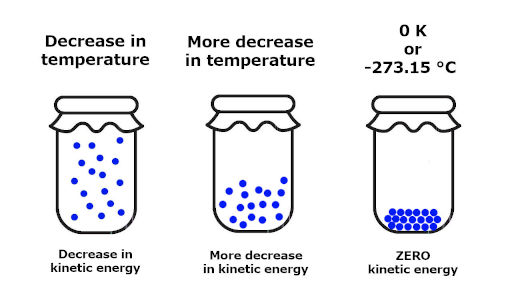
If we keep on reducing the temperature of the body, then all the molecules and atoms will stop the motion and they will be completely freezed.
As you can see in the above images, as the temperature keeps on decreasing, the motion of molecules is also decreasing. In the last part, you can see that all the molecules are freezed and they are not moving. The kinetic energy of these molecules becomes zero at absolute zero temperature.
Even gases like hydrogen, helium, oxygen get freezed up and become solids at this temperature.
Is absolute zero temperature possible?
The answer is “No”
Scientists know that such temperature exist. But they have never been able to achieve this lowest temperature even by using many scientific techniques and freezers. Scientists have achieved temperature somewhat close to absolute zero in a laboratory, but not exactly 0 K.
Why is absolute zero not possible? (simple)

You know why this temperature is not reachable?
I’ll explain to you in a short and simple way.
According to the second law of thermodynamics, heat will move from the warmer body to a colder body. So if we try to cool down the object to absolute zero, then that object will keep on receiving heat from the surrounding and so it’s just a theoretical concept.
Thus absolute zero temperature is practically not possible.
What is a pure crystalline substance in the third law of thermodynamics?
Well, this is very easy. You will get to know what a pure crystalline substance is and how it is related to the third law of thermodynamics.
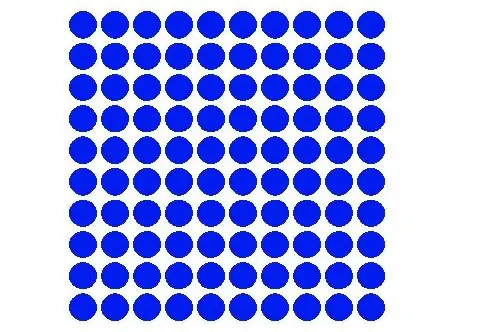
The atoms in a perfect crystalline substance look something like this.
- All the atoms are of same size and
- They are arranging in a perfect order.
I mean to say that, all the atoms are of same size and at equal distance to each other.
This type of substance is known as perfect crystalline substance or pure crystalline substance.
Now let me tell you, how this is related to the 3rd law of thermodynamics.
Third law of thermodynamics says that if this type of pure crystalline substance is exposed to absolute zero temperature (i.e 0 Kelvin), then it’s entropy will be “zero”.
S 0 K = 0
The crystal structure can be known from the unit cell structure of that crystal. Unit cell is nothing but an imaginary box which shows the arrangements of atoms in it. This unit cells combines to form a big 3D Crystal.
The perfect crystal is a substance with almost no imperfections. Third law of thermodynamics is all about these pure crystalline substances.
Now which substances are not a pure crystalline substance?
- The arrangements of atoms are not perfect
- There is some disorder or randomness in the substance
If the entropy of a substance is not zero at absolute zero temperature, then the substance will not be perfectly Crystalline.
S 0 K ≠ 0
How can we find whether the substance is pure crystalline or not using the third law of thermodynamics?

See guys, it is not always true that the entropy of all the substances will be zero at absolute zero temperature.
But what is the proof for that?
Let me explain this to you.
Third law of thermodynamics is all about perfectly crystalline substances. It states that the entropy of a perfectly Crystalline substance will be zero at 0 Kelvin temperature. That means if the substance is not perfectly crystalline, then its entropy will not be zero at 0 Kelvin temperature.
And such substances are not pure crystalline substances.
These substances will have some imperfections in their crystal structure. These substances will show some disorder or randomness.
This disorder or randomness is also known as residual entropy.
Are you getting what I am saying? (Let me know in comments, if you have any doubts).
Which substances do not follow the third law of thermodynamics?
Third law of thermodynamics is not applicable to all the substances. There are many substances which do not obey 3rd law of thermodynamics.
Let me give you some examples:
- CO (carbon monoxide)
- HCl (Hydrochloric acid)
These molecules may not obey the third law of thermodynamics. But why?
See, the kinetic energy of all the molecules will be zero at absolute zero temperature. But when there will be a crystal formation of CO at 0 K temperature, the arrangements of all the CO molecules will not be the same.
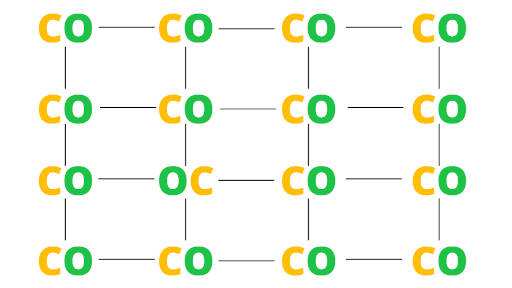
See this image, the molecules are not ordered because all the CO molecules are not present over here. You can see that there is one OC molecule in the structure. That is the disorder in the structure. Thus it has some residual entropy at this zero Kelvin temperature. Thus even at zero Kelvin temperature, these molecules do not show zero entropy. Such molecules do not obey the Third law of thermodynamics.
Generally, diatomic molecules may not obey the 3rd law of thermodynamics because there is a possibility that the molecules will be arranged in alternate way as shown in the example of CO (carbon monoxide).
Thus such diatomic molecules may not show zero entropy at absolute zero temperature.
(Note: This is experimental. No one has achieved absolute zero temperature till now)
Why are you studying third law? What are its applications?

Now the main question is, why are we studying the third law of thermodynamics?
Let’s see the application of the third law of thermodynamics.
Once you have studied the third law, you can easily find the absolute entropy of any substance at a given temperature.
You just have to compare the entropy of a given substance at T temperature with the entropy of that substance at zero Kelvin temperature.
We have to calculate the change in entropy between these temperatures.
ST – S0 = ∆S (1)
Now, we know that at 0 K temperature, the entropy will be zero. (So, S0 =0).
We can easily find the change in entropy (∆S ), using the formula.
ΔS = ST – S0 = 0∫T Cp dT/T
Now, after getting this entropy change, we can easily get the entropy at a given temperature (ST) from the above equation (1).
Third law of thermodynamics Equation/Mathematical form
Its amazing, this is quite interesting topic.
You might be knowing that we can calculate the change in entropy using this formula.
S – S0 = kB lnΩ
Here,
- S = entropy of the system
- S0 = initial entropy
- kB = Boltzmann constant
- Ω = total number of microstates
If a substance is perfectly Crystalline, then its total number of microstates will be 1 (Ω = 1).
Now from the above equation, we get;
S – S0 = kB lnΩ
= kB ln(1)
= 0. (Because ln 1 = 0)
Now, When the initial entropy of the system is taken as zero, the value of entropy S can be calculated easily.
Thus from above equation, we get;
S – 0 = 0
Therefore, S = 0
Thus, the entropy of a pure crystalline substance is “zero” at absolute zero temperature.
Summary (read this if you are in hurry)
What is Randomness and Entropy in Third law?
Solids show less movement of molecules, liquids have more movement of molecules and gases show maximum movement of molecules.
This movement of molecules is known as randomness.
Entropy: The measurement of randomness of the system is known as Entropy.
Or
Entropy is the measurement of disorder of the system.
Third law of thermodynamics:
“The value of entropy of a completely pure crystalline substance is zero at absolute zero temperature”
What is absolute zero temperature? Is it possible to achieve?
Absolute zero temperature is the coldest possible temperature in the universe (and it is 0 K).
Is absolute zero temperature possible?
The answer is “No”
Why is absolute zero not possible?
According to the 2nd law of thermodynamics, heat will move from the warmer body to a colder body. So if we try to cool down the object to absolute zero, then that object will keep on receiving heat from the surrounding and so it’s just a theoretical concept.
Thus absolute zero temperature is practically not possible.
What is a pure crystalline substance in the third law of thermodynamics?
The perfect crystal is a substance with almost no imperfections.
How can we find whether the substance is pure crystalline or not using the third law of thermodynamics?
Third law of thermodynamics is all about perfectly crystalline substances. It states that the entropy of a perfectly Crystalline substance will be zero at 0 Kelvin temperature. That means if the substance is not perfectly crystalline, then its entropy will not be zero at 0 Kelvin temperature.
And such substances are not pure crystalline substances.
Which substances do not follow the third law of thermodynamics?
Generally, diatomic molecules may not obey the 3rd law of thermodynamics because there is a possibility that the molecules will be arranged in alternate way as we discussed in the example of CO (carbon monoxide).
Thus such diatomic molecules may not show zero entropy at absolute zero temperature.
(Note: This is experimental. No one has achieved absolute zero temperature till now)
Why are you studying third law? What are its applications?
Once you have studied the third law, you can easily find the absolute entropy of any substance at a given temperature.
Important Guides for you
Also read:
- What is thermodynamics? (35+ topics with definitions and examples)
- Zeroth law of thermodynamics
- What is First law of thermodynamics?
- First law of thermodynamics definition/statement (In simple way)
- Examples of First Law of Thermodynamics / Law of conservation of Energy
- First law of thermodynamics equation (A practical explanation)
- Limitations of First Law of Thermodynamics
- What is second law of thermodynamics? [8+ Best examples to remember the law]
- Examples of Second Law of Thermodynamics (8+ best examples)
- Second Law of Thermodynamics Definition/Statement (Next level explanation)
- Second Law of Thermodynamics Equation [Practical explanation]
- Laws of thermodynamics
- What is Carnot Cycle in Thermodynamics?
- What is the definition of entropy in thermodynamics?
- Heat capacity vs specific heat in thermodynamics
- What is Thermodynamic Equilibrium? (With Best Example)
- Thermodynamic Process (With Examples)
- What is Thermodynamic System? – Open, Closed & Isolated system (With Examples)
